Are you looking to launch a smart adult toy but feel overwhelmed by the technical hurdles? The fear of faulty electronics, buggy apps, and high costs can be paralyzing, potentially damaging your brand’s reputation. The key is to understand these challenges upfront with a manufacturing partner who has solved them before.
To successfully manufacture smart adult toys, you need to partner with a factory that excels at integrating complex electronics, like PCBs and Bluetooth modules, into body-safe silicone. Key success factors include rigorous, multi-stage quality control, stable app development, and careful material selection that ensures waterproofing, durability, and signal integrity. This holistic approach prevents product failures and builds lasting customer trust.
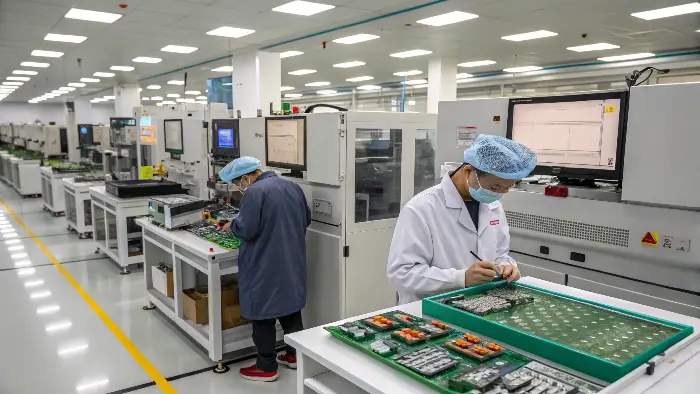
As someone who has been in the manufacturing industry for years, I’ve seen many brands with fantastic ideas for smart products. But I’ve also seen how easily a project can go wrong without the right expertise. The difference between a best-selling smart toy and a discounted failure often comes down to mastering a few critical areas of production. It’s not just about making a vibrator; it’s about creating a reliable piece of consumer electronics that is also intimate and body-safe. Let’s break down the biggest challenges I see and, more importantly, how to solve them.
What Makes Integrating Electronics into Adult Toys So Complex?
You have a brilliant idea for a new app-controlled toy, but the thought of fitting all that tech into a sleek, flexible, waterproof shell is daunting. It can feel like putting a ship in a bottle. The solution isn’t luck; it’s a meticulous design-for-manufacturing process from day one.
The complexity comes from three main areas: miniaturization, waterproofing, and heat management. You must fit sensitive components like printed circuit boards (PCBs), batteries, motors, and antennas into a very small, sealed silicone body. Ensuring the electronics function perfectly without overheating, all while being completely waterproof and comfortable for the user, is the central engineering challenge.
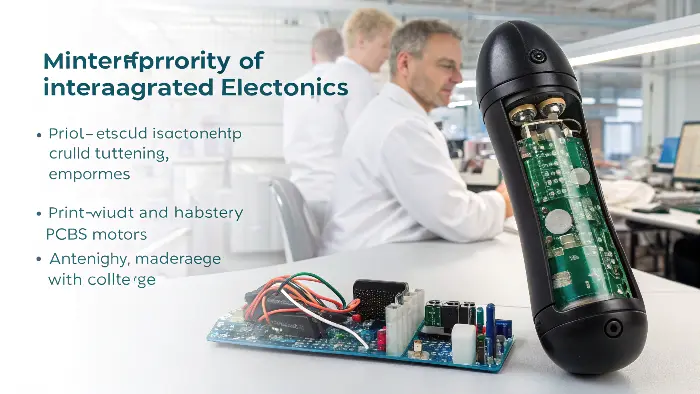
Dive Deeper: The Delicate Dance of Hardware and Housing
Integrating smart technology is much more than just adding a Bluetooth chip. It’s a delicate balancing act where every millimeter matters. At PrivyPlay, we approach this by breaking the challenge down into distinct parts.
First, there’s the issue of miniaturization and component layout. The internal components—the PCB, battery, and motor—must be arranged to prevent electronic interference. For example, the Bluetooth antenna needs a clear path to the outside of the toy, unobstructed by the motor or battery, to ensure a strong and stable connection. We often design a rigid internal skeleton, usually from ABS plastic, to hold these components securely in place within the flexible silicone exterior.
Next, waterproofing is non-negotiable. For a non-smart toy, this is relatively simple. For a smart toy with a magnetic charging port, it’s much harder. We use techniques like two-shot injection molding or overmolding, where the outer silicone layer is chemically bonded to the inner plastic shell, creating a seamless seal. Every single unit must then undergo air-pressure testing to ensure it meets its IPX7 waterproof rating. A single weak point in the seal can destroy the electronics and your brand’s reputation.
Finally, we have to manage heat dissipation. The motor and the battery both generate heat during use. In a sealed, insulated silicone environment, that heat has nowhere to go. This is a safety and comfort issue. We solve this by selecting energy-efficient motors and engineering small air gaps or using thermally conductive materials internally to help distribute heat away from any single point, ensuring the toy’s surface remains comfortable to the touch.
| Component Challenge | Key Manufacturing Solution |
|---|---|
| Miniaturization | Custom PCB design and internal ABS skeleton for stability. |
| Waterproofing | Overmolding techniques and 100% unit air-pressure testing. |
| Signal Integrity | Strategic antenna placement, away from motors and batteries. |
| Heat Dissipation | Use of efficient components and internal thermal management. |
How Do You Choose the Right Materials for Smart Sex Toys?
You know that body-safe silicone is the gold standard for any adult product. But when you add smart technology, you start to wonder: will the silicone block the Bluetooth signal? Is it tough enough to protect the expensive electronics inside? Material selection for smart toys is about more than just feel and safety.
Choosing the right materials requires balancing body safety, electronic compatibility, and structural durability. You need premium, medical-grade silicone for all external surfaces, but a rigid material like ABS plastic is often necessary for the internal chassis that protects the electronics. The crucial factor is ensuring the chosen materials do not block wireless signals and can be perfectly sealed for a high waterproof rating.
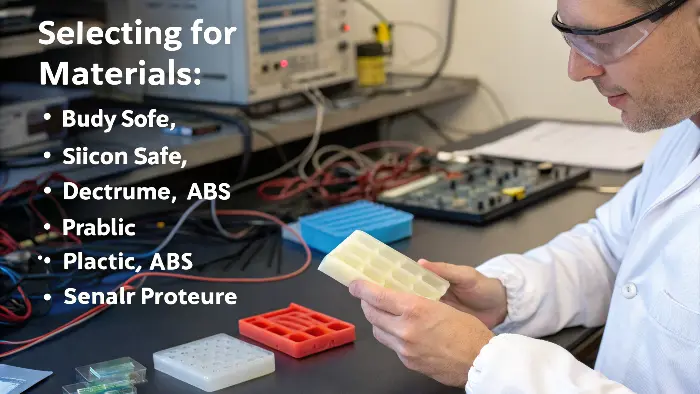
Dive Deeper: More Than Just Silicone
The material choices for a smart toy are fundamentally different from those for a simple vibrator. You are creating a housing that must be soft and pleasurable on the outside, but rigid and protective on the inside.
The outermost layer must be 100% body-safe, medical-grade silicone. There is no compromise here. It’s hypoallergenic, non-porous, and easy to clean. However, silicone alone is too flexible to properly secure fragile electronics and prevent them from damage if the toy is dropped or squeezed. This is why we build a product around an internal chassis, typically made from robust ABS plastic. This "skeleton" holds the PCB, motor, and battery in their precise positions, protecting them from impact and ensuring the antenna has a clear line of sight.
A critical, and often overlooked, factor is signal permeability. Some materials, especially those with certain additives or pigments, can interfere with or block radio frequencies like Bluetooth. Part of our R&D process involves testing material samples to measure their impact on signal strength. We once had a client who wanted a specific metallic-looking finish on a toy. In testing, we found it cut Bluetooth range by over 50%. We worked with them to find an alternative pigment that achieved a similar aesthetic without compromising the core smart functionality.
This interplay between materials also dictates the manufacturing process. The ability for the outer silicone to form a perfect, permanent bond with the inner ABS chassis during the overmolding process is essential for waterproofing.
| Material | Primary Use | Key Consideration for Smart Toys |
|---|---|---|
| Medical-Grade Silicone | Outer body, user contact points | Must be a grade that allows for strong bonding with the inner shell. |
| ABS Plastic | Internal chassis/skeleton | Provides rigidity and protection for electronics. |
| TPE/TPR | Lower-cost alternative | Generally not recommended for smart toys due to sealing issues and lower durability. |
| Polycarbonate (PC) | Transparent internal parts | Can be used for light effects, but must be structurally sound. |
Why is App Connectivity and Software Stability a Major Hurdle?
Your smart toy hardware is a work of art, engineered to perfection. But the app crashes constantly, the connection is unreliable, and your product reviews are tanking. This is a common nightmare because a great app requires a completely different skill set than great hardware.
App connectivity is a major hurdle because stable software development is a specialized field separate from physical manufacturing. It involves mastering Bluetooth protocols, creating an intuitive user interface (UI/UX), and committing to regular updates for new iOS and Android versions. A buggy app makes even the highest-quality hardware feel cheap, directly damaging your brand’s credibility.
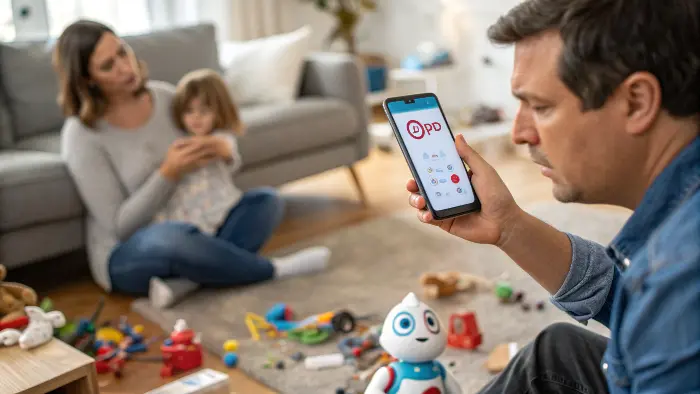
Dive Deeper: The Unseen Half of Your Product
Too many brands treat the app as an afterthought. In reality, the software is the product, just as much as the physical toy. A customer’s experience is defined by how seamlessly the two work together. This creates a two-sided challenge: the firmware on the toy and the software on the phone.
The firmware is the mini-operating system on the toy’s PCB. It controls the motors, reads battery levels, and manages the Bluetooth connection. The app is the user-facing control panel on their phone. These two systems must speak the same language flawlessly. Any miscommunication results in lag, dropped connections, or commands that don’t work. We ensure success by having our hardware and software teams work in parallel from the very beginning of a project, not in sequence.
Beyond just connecting, the app needs an exceptional User Interface (UI) and User Experience (UX). Is it easy to pair the toy for the first time? Are the controls intuitive? Can users create and save their own patterns easily? A confusing or frustrating app will lead customers to abandon it, turning your smart toy into a "dumb" one. I always advise clients to invest in professional UI/UX design, because a simple, clean interface is a sign of a premium product.
Finally, software requires long-term maintenance. Every time Apple or Google releases a major OS update (like iOS 18 or Android 15), it can potentially break your app’s connectivity. A reliable manufacturing partner must offer ongoing software support to patch the app and ensure it keeps working for years after the initial purchase. This is a long-term commitment that protects your customers and your brand.
| App Development Stage | Key Goal | Why It’s Crucial for a Smart Toy |
|---|---|---|
| 1. Protocol Definition | Define how the app and toy will communicate. | A solid foundation prevents future bugs and connection issues. |
| 2. UI/UX Design | Create visual mockups and user flows. | Ensures the app is intuitive and enjoyable to use. |
| 3. Core Development | Build the app for iOS and Android. | The actual coding of the app’s features and logic. |
| 4. Integrated Testing | Test the app with physical prototype toys. | Finds bugs between the hardware, firmware, and software. |
| 5. Launch & Maintenance | Publish to app stores and provide ongoing updates. | Protects against OS changes and keeps the product working. |
What Does Robust Quality Control for Smart Toys Actually Involve?
You’ve approved the final prototype, and it works perfectly. But how do you ensure that all 5,000 units in your first production run work just as well? For a smart toy, standard quality control isn’t enough. You need a multi-stage process that tests every single aspect of the product.
Robust quality control for a smart toy is a comprehensive, multi-layered process that goes far beyond a simple function check. It involves testing raw electronic components, checking waterproof seals during assembly, functionally testing every unit for app pairing and motor response, and conducting batch stress tests for durability. Anything less risks a high rate of defective units reaching your customers.
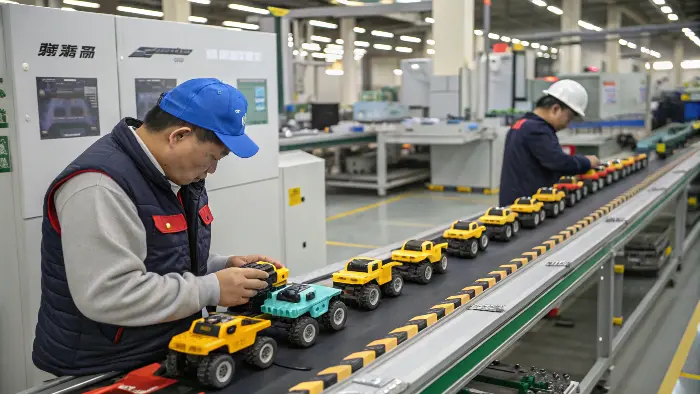
Dive Deeper: A Quality Checklist from Start to Finish
A single faulty unit can lead to a damaging online review. That’s why our QC process for smart products is so intensive. We can’t just check the toy at the end of the line; we have to build quality in at every step.
It starts with Incoming Quality Control (IQC). We test the raw materials and components before they even enter the assembly line. This includes testing batches of PCBs, batteries, motors, and even the raw silicone to ensure they meet our specifications. Catching a bad batch of batteries here is much cheaper than finding out after they’ve been sealed inside 1,000 toys.
Next is In-Process Quality Control (IPQC). We conduct checks at critical points during assembly. The most important of these is the waterproof test. We test the empty, sealed shell for leaks before the electronics are installed. Then, after the electronics are installed and the toy is permanently sealed, we test it again. This redundancy is key.
Then comes Final Quality Control (FQC), which is the most comprehensive step. Here, 100% of the finished products undergo a full functional test. This isn’t just turning it on and off. Each toy is:
- Charged to ensure the charging port works.
- Paired with a test device to confirm Bluetooth connectivity.
- Run through every vibration pattern via the app to check motor response.
- Inspected visually for any cosmetic defects in the silicone.
Finally, we perform Outgoing Quality Assurance (OQA). We randomly select a percentage of packaged products from a finished batch and repeat the entire FQC process. This simulates the customer’s unboxing experience and is our last chance to catch any systemic issues before the shipment leaves our factory. This rigorous process is the only way to ensure the reliability your brand and customers expect.
How Can You Manage the Higher Costs and MOQs of Smart Toys?
You’re excited by the potential of a smart toy, but the development costs and high Minimum Order Quantities (MOQs) from factories feel like a massive barrier. It’s a classic chicken-and-egg problem: you need to sell a lot to afford the high MOQ, but you can’t afford the MOQ until you’ve sold a lot.
You can manage the higher costs and MOQs of smart toys by partnering with a manufacturer who understands the needs of growing brands. This involves focusing on a Minimum Viable Product (MVP) to reduce initial R&D, seeking flexible MOQ options, and understanding that the upfront investment in quality electronics and app development prevents far costlier issues like product returns and brand damage later on.

Dive Deeper: A Smart Investment Strategy
The financial leap from a standard toy to a smart toy is significant, but it doesn’t have to be a blind one. The key is to understand where the costs come from and to approach it as a strategic investment.
First, let’s break down the costs. Unlike a simple vibrator, a smart toy has major upfront expenses in non-recurring engineering (NRE). This includes:
- Electronics R&D: Designing and prototyping the custom PCB.
- App Development: A significant cost, often ranging from $10,000 to $50,000+ for a stable, polished app.
- Tooling & Molds: While all toys need molds, smart toys often require more complex and precise molds for the internal chassis and overmolding process.
- Certifications: FCC/CE certifications for wireless communication are mandatory and add to the cost.
So how do you make this manageable? One effective strategy is to launch with a Minimum Viable Product (MVP). Instead of building an app with a dozen complex features, start with the core essentials: solid connectivity, basic controls, and maybe one or two unique pattern modes. You can add more features later through app updates. This reduces the initial software development cost and gets you to market faster.
Regarding MOQs, communication with your manufacturer is key. While the MOQ for custom electronics is often high due to component sourcing, a flexible partner like PrivyPlay can sometimes offer solutions. We might be able to start with a smaller trial run if it’s based on one of our existing, proven electronic platforms. This allows you to test the market without committing to a massive inventory. It’s always worth asking what’s possible. Ultimately, viewing the higher upfront cost as an investment in a premium product with a higher retail price and better long-term brand value is the right mindset for success.
| Cost Driver | Simple Toy Cost | Smart Toy Cost | Strategy to Manage |
|---|---|---|---|
| Unit Electronics | Low | High | Use proven-platform components to reduce custom R&D. |
| App Development | N/A | Very High | Launch with an MVP and add features over time. |
| Molding | Standard | High | Simplify design where possible without losing function. |
| MOQ | Lower | Higher | Negotiate a smaller pilot run to test the market first. |
Conclusion
Navigating the world of smart toy manufacturing involves mastering electronics, materials, software, and rigorous quality control. It’s complex, but not impossible. The key is approaching it with a clear strategy and, most importantly, collaborating with a manufacturing partner who has the specialized expertise to guide you. That partnership transforms challenges into opportunities.
